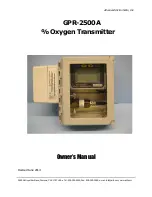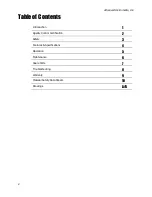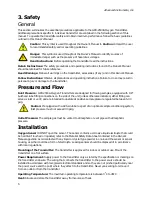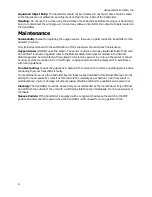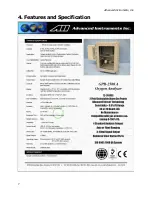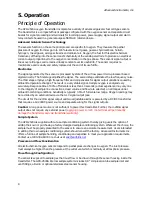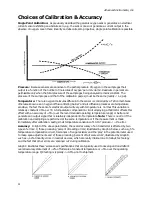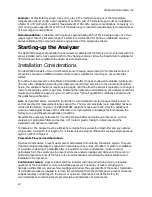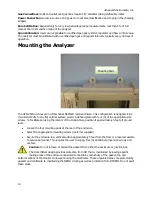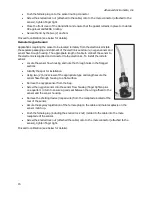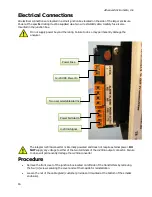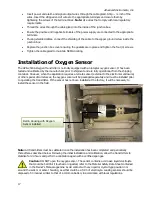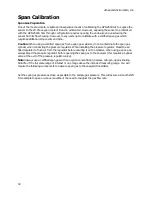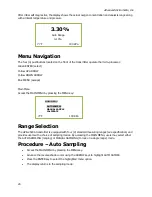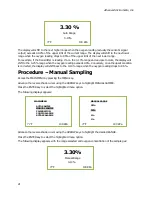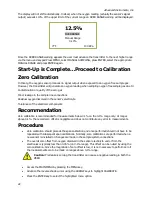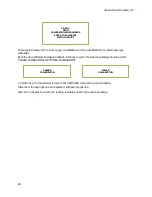
Advanced Instruments, Inc.
Example: As illustrated by Graph A any error, play in the multi-turn span pot or the temperature
compensation circuit, during a span adjustment at 20.9% (air) of full scale range would be multiplied by
a factor of 4.78 (100/20.9) if used for measurements of 95-100% oxygen concentrations. Conversely, an
error during a span adjustment at 100% of full scale range is reduced proportionately for measurements
of lower oxygen concentrations.
Recommendation: Calibrating with a span gas approximating 80% of the full scale range one or two
ranges higher than the full scale range of interest is recommended for 'optimum calibration accuracy'.
Always calibrate at the same temperature and pressure of the sample gas stream.
Starting-up the Analyzer
The GPR-2500A Oxygen Transmitter has been tested, calibrated at the factory prior to shipment with the
sensor installed and is fully operational from the shipping container. Allow the transmitters to stabilize for
30 minutes and then recalibrate the device as instructed below.
Installation Considerations
The GPR-2500A consists of two circuit boards, sensor housing and sample 1/8” sample inlet and vent
connections housed in a NEMA 4X rated enclosure and is suitable for mounting on any vertical flat
surface.
For optimum accuracy zero and calibrate a transmitter after it has been allowed to stabilize, typically 24-
36 hours after installation. Assuming the initial zero is performed according to the procedure described
herein, the analyzer should not require zeroing again until the either the sensor is replaced or a change is
made to the sample system or gas lines. Following the initial zero and calibration, the analyzer should not
require span calibration again for up to 3 months under “normal” application conditions as described in
the published specifications.
Note:
As described below, zeroing the transmitter is recommended only for measurements below 1%
and not practical for measurement ranges above 1%. The low end sensitivity (zero capability) has been
verified at the factory; however, no ZERO OFFSET adjustment has been made. A factory adjustment
would be meaningless because of the difference in sample systems and leakage factors between the
factory set-up and the actual application conditions.
Assemble the necessary hardware for mounting the transmitter and optional components - such as
coalescing or particulate filters and pumps, 1/8” metal or plastic tubing for interconnecting the
transmitter and optional components.
Temperature: The sample must be sufficiently cooled before it enters the transmitter and any optional
components. A coiled 10 foot length of ¼” stainless steel tubing is sufficient for cooling sample gases as
high as 1,800ºF to ambient.
Pressure & Flow as described above
Moisture & Particulates: Prevent water and/or particulates from entering the sample system. They can
clog the tubing and damage the optional components such as pumps, scrubbers or sensors. Installation
of a suitable coalescing or particulate filter is required to remove condensation, moisture and/or
particulates from the sample gas to prevent erroneous analysis readings and damage to the sensor or
optional components. Consult the factory for recommendations concerning the proper selection and
installation of components.
Contaminant Gases: A gas scrubber and flow indicator with integral metering valve are required
upstream of the transmitter to remove interfering gases such as oxides of sulfur and nitrogen or
hydrogen sulfide that can produce false readings and reduce the expected life of the sensor. Installation
of a suitable scrubber is required to remove the contaminant from the sample gas to prevent erroneous
analysis readings and damage to the sensor or optional components. Consult the factory for
recommendations concerning the proper selection and installation of components.
12


